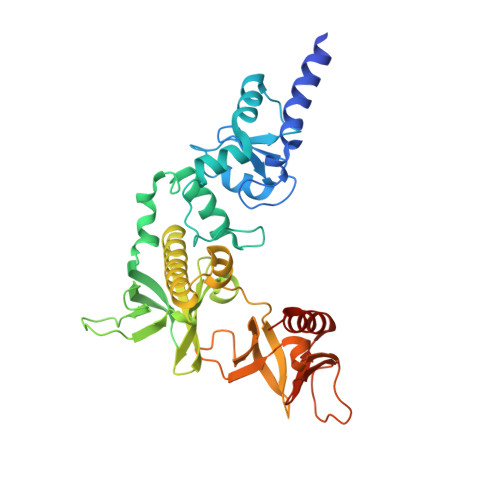Phosphorylation-independent dual-site binding of the FHA domain of KIF13 mediates phosphoinositide transport via centaurin {alpha}1.
Tong, Y., Tempel, W., Wang, H., Yamada, K., Shen, L., Senisterra, G.A., Mackenzie, F., Chishti, A.H., Park, H.W.(2010) Proc Natl Acad Sci U S A 107: 20346-20351
- PubMed: 21057110
- DOI: https://doi.org/10.1073/pnas.1009008107
- Primary Citation of Related Structures:
3FEH, 3FM8, 3LJU - PubMed Abstract:
Phosphatidylinositol 3,4,5-triphosphate (PIP3) plays a key role in neuronal polarization and axon formation. PIP3-containing vesicles are transported to axon tips by the kinesin KIF13B via an adaptor protein, centaurin α1 (CENTA1). KIF13B interacts with CENTA1 through its forkhead-associated (FHA) domain. We solved the crystal structures of CENTA1 in ligand-free, KIF13B-FHA domain-bound, and PIP3 head group (IP4)-bound conformations, and the CENTA1/KIF13B-FHA/IP4 ternary complex. The first pleckstrin homology (PH) domain of CENTA1 specifically binds to PIP3, while the second binds to both PIP3 and phosphatidylinositol 3,4-biphosphate (PI(3,4)P(2)). The FHA domain of KIF13B interacts with the PH1 domain of one CENTA1 molecule and the ArfGAP domain of a second CENTA1 molecule in a threonine phosphorylation-independent fashion. We propose that full-length KIF13B and CENTA1 form heterotetramers that can bind four phosphoinositide molecules in the vesicle and transport it along the microtubule.
Organizational Affiliation:
Structural Genomics Consortium, University of Toronto, Toronto, ON M5G 1L7, Canada.
















